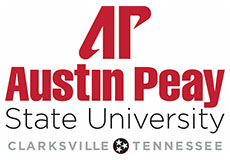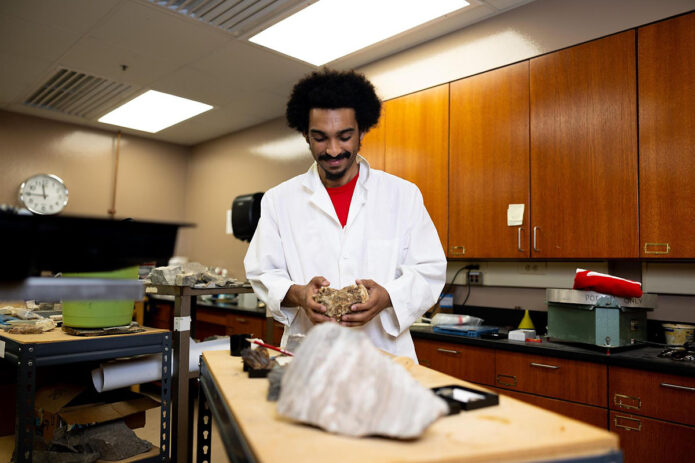 Clarksville, TN – Austin Peay State University (APSU) geosciences student Dairian Boddy has already significantly impacted geology through innovative research and presentations.
Clarksville, TN – Austin Peay State University (APSU) geosciences student Dairian Boddy has already significantly impacted geology through innovative research and presentations.
Boddy, set to graduate in 2024 with a bachelor’s degree in earth and environmental science, made a mark with his innovative research and well-received presentation at the 2023 Geological Society of America’s (GSA) annual meeting. His sights are set on a future in volcanology and advancing in critical mineral research.
Boddy describes his academic journey as evolving from an interest in natural disasters to a fascination with geology.
[470cneter]
“My academic journey began with the intention of getting a degree that indulged my interest in natural disasters and has evolved into a fascination with the ground beneath our feet,” he said.
His academic achievements include presenting at multiple GSA conferences and representing APSU’s earth and environmental sciences department at leadership panels. He recalls his Denver GSA presentation as a significant milestone.
“It was the best thing ever,” Boddy said, reminiscing about his first presentation at the GSA annual meeting in Denver, Colorado. “I was nervous, but I rehearsed it. I didn’t take note cards. I didn’t take anything. I didn’t want to take away from the experience.”
Boddy’s journey to national recognition began when he collaborated with Dr. Erik Haroldson, an earth and environmental sciences professor at Austin Peay. Together, they embarked on a research project exploring Mississippi Valley-type deposits, focusing on areas in Tennessee and Kentucky.
“Our overall research pertains to further understanding Mississippi Valley Type deposits, their potential to yield critical minerals (e.g., galena), and information about their origins. We are looking further into this by making fluid inclusion slides,” Boddy said.
Serendipity struck as they stumbled upon a unique zinc vein near Russellville, Kentucky.
“We were driving and talking, and we saw this big blob of white stuff,” Boddy said. “Dr. Haroldson lit up like it was a goldmine. This is stuff that he’d been researching. I’ve never seen him react like this.”
The discovery of this zinc vein opened new doors of exploration and laid the groundwork for Boddy’s academic journey. The duo unraveled fascinating insights as they took samples to Austin Peay State University for further research. They examined finely cut samples through radiogenic isotope analysis at the University of Texas in Austin. Radiogenic isotope analysis is a technique geologists use to determine the age of rocks and understand geological processes.
“After looking at all of our data before finding this vein, we realized that it shouldn’t have been there,” Boddy said. “We wanted to learn more about it, and I think we’ve opened the doors for others to look at this.”
‘Rewarding and Uplifting’

Boddy’s dedication and passion for geology are clear in his academic pursuits and ability to communicate complex concepts to a broader audience.
Through his experiences at the GSA and other conferences, Boddy gained an essential insight into the significance of clear communication.
“My experiences have helped me understand how important it is to practice communicating our research to audiences that know nothing about what we do in a digestible manner,” he said.
Boddy acknowledged that experts often unintentionally overcomplicate their explanations, forgetting that not all audience members have the same level of understanding.
“One of my major goals is to better explain complex geological concepts in a simpler manner so people can learn and understand the interesting aspects of geology,” he said.
Boddy already has made significant strides toward this goal, Haroldson said.
“Dairian was able to use what he had learned over the last three to four years to explain his research to an audience that knows next to nothing about geology,” he said. “The fact that he could describe his work accurately and confidently in a way that maintained their interest was both a rewarding and uplifting experience.”
Boddy’s success at the GSA annual meeting fueled his determination to further contribute to the earth and environmental sciences field. He is passionate about continuing his education beyond his undergraduate studies at Austin Peay State University.
“Before I went to the GSA in Colorado, I was interested in volcanology, dealing with volcanoes,” Boddy said. “But now that I went to the conference, I want to work more with geochemistry, the chemistry that leads to the creation of minerals.”
He looks to become a “jack of all trades” in geosciences, exploring diverse topics that captivate his curiosity.
“I can’t answer what exactly I want to specialize in at the moment because I still have an overall fascination with geology,” he said. “I intend to apply for my master’s at a school somewhere out west and hopefully work towards my doctorate sometime soon.”
Experience and Growth
As Boddy and fellow earth and environmental sciences student Marc Donegan continue to delve into the study of fluid inclusions and collaborate with experts from different institutions, their research is gaining momentum. They will present at the upcoming GSA annual meeting in Pittsburgh, Pennsylvania.
“Dairian, Marc, and I are now preparing samples for lab analysis at UT-Austin and making plans on what to present this fall at the annual GSA meeting,” Haroldson said in July 2023.
Beyond the accolades and academic achievements, Boddy’s research has significant implications for the future. Working under a grant from the American Chemical Society Petroleum Research Fund, Boddy and Donegan have investigated regional mineralizing fluid systems that occurred hundreds of millions of years ago.
“I’ve most enjoyed working with the students and mentoring them about scientific research and how to take this experience and grow into academe or whatever career path they choose,” Haroldson said.
Boddy’s achievements thus far are a testament to his dedication, perseverance, and love for geology. With the support of the grant, they have made significant strides in understanding regional mineralization processes, laying the foundation for further research and publication.



